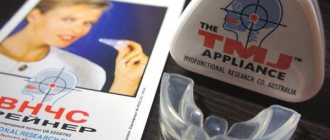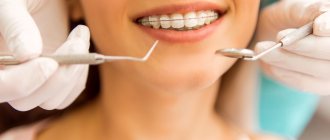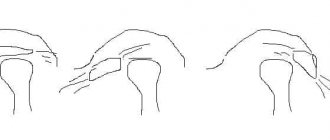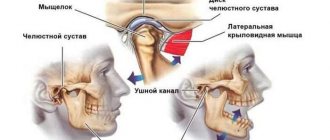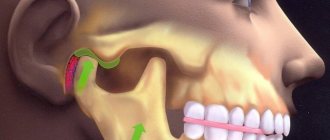2971
Splinting has always remained the main method of eliminating dysfunction of the TMJ (temporomandibular joint).
But, for some time now, most violations began to be corrected with specially designed joint splints.
The studies revealed that the defects respond well to treatment with the TMJ splint from MRC.
General information and purpose
The TMJ splint is a rigid, removable, thermo-modeling device that is worn like a mouthguard on one of the jaws.
The device is intended for intraoral use in adult patients. The design and construction were developed using a computer system. Supplied with preset parameters.
The splint is of great importance for doctors, as it allows them to begin correcting functional disorders already during the initial appointment.
System and oral care
Caring for the device and the oral cavity while wearing it is extremely simple and does not cause any difficulties. Necessary:
- After each use, rinse Myosa TMJ in warm running water, dry and place in its case.
- Clean it twice a week with a special cleaner, such as Myoclean TM from MRC.
Do not scratch, squeeze or chew the mouthguard. This can lead to delamination of its occlusal linings and impaired functionality in relation to the masticatory muscles and jaw position.
Design Features
Structurally, this device is a two-layer apparatus, the outer thermoplastic shell of which quickly softens when lowered into hot water.
Fitting onto the jaw arch, it sets it in the correct position due to the constant shape of its base.
The splint has a rigid wing-shaped base , the dimensions of which are considered ideal for decompression of the temporal joint. There are 2 models of the device available: with a base thickness of 4 mm or 2 mm.
Each wing of the device extends forward and backward beyond the molars by 2 mm and 2.5 mm, respectively, which provides effective support for the lateral dental units.
The stopper provided in the design restrains lateral movements, and a special tongue guard eliminates the possibility of the tongue sinking or swallowing.
Purpose of the T4k pre-orthodontic blue and pink trainer and its principle of operation.
Read here what problems can be solved with the help of orthodontic trainers for adults.
At this address https://www.vash-dentist.ru/ortodontiya/kapyi/ot-hrapa-alternativa-hirurgicheskomu-vmeshatelstvu.html we’ll talk about the effectiveness of an anti-snoring mouth guard and how it works.
TMJ appliance joint splint for the correction of articular disorders (TMJ mouthguard)
The TMJ device (articular splint) is intended for intraoral use in adult patients. It does not require special fitting, manufacturing or correction. Its unique design combined with low cost makes treatment for joint disorders more accessible.
Bruxism and teeth grinding are controlled thanks to the wing-shaped base and the double mouth guard effect
Joint splint The device for TMJ is a soft dental splint that is used to treat the first symptoms of TMJ dysfunction. The unique design of the splint allows you to begin immediate treatment with minimal time, since the device does not require taking impressions, special fitting and correction (with the exception of trimming the distal ends of the splint taking into account the length of the dental arch). The TMJ device eliminates the symptoms of dysfunction through decompression (wing-shaped base) and eliminates the effect of bruxism (double oral protection). When fitting the device in the oral cavity, muscle relaxation is observed and the tension of the craniomandibular muscles decreases. Recommended wearing time is 1 hour daily plus during sleep. • It is possible to begin treatment for TMJ dysfunction immediately after the first consultation visit. • Universal size. Suitable for all patients. • Does not require taking impressions, manufacturing or correction. Time costs are zero. • Symptoms of dysfunction are reduced or completely disappeared without any additional procedures. • Can be used for diagnostic purposes at minimal time and cost. • The soft silicone design is ideal for eliminating the initial symptoms of TMJ dysfunction (joint pain, muscle pain, etc.), unlike hard acrylic and vacuum splints. • The package contains instructions for use for the patient. • Dry heat sterilization. • Low cost of initial treatment is affordable for most patients. Design Features The design of the joint apparatus was developed using a computer design system. It comes pre-formed and serves as an initial yet immediate treatment for TMJ dysfunction. The joint splint is made of silicone in the shape of the ideal dentition, is very flexible and easily adapts to both wide and narrow dental arches. No impressions or additional processing required. The possible correction is minimal (in cases of narrow dental arches, the distal ends of the splint can be trimmed with scissors). Universal size. It's hard to believe, but patients who are not suitable for this device are very rare. There is no need for “fit” in the sense of wearing comfort. The splint has value for practitioners because you offer immediate treatment at the first consultation visit with minimal time investment. Without the time to make your own tire, you offer something that actually works. It even includes instructions for use for patients! It does not require boiling or taking casts and, at the same time, has an immediate purpose. The patient can wear the splint for a few minutes, which is already a definite initial treatment. The main characteristics and design of the joint device contribute to some relief already at the initial stage. Joint decompression and limitation of function Doctors, in particular therapists, argue that the first stage of treatment for inflammatory processes in the joint is to relieve inflammation and muscle pain through decompression and limitation of function. The joint apparatus takes into account all these principles to reduce the severity of symptoms of dysfunction. Support splint The joint appliance has a wing-shaped base with a thickness of 4.5 mm in the molar area and extends anteriorly and posteriorly to 2mm and 2.5mm respectively. This provides effective support for most patients with a full set of posterior teeth. In addition to this, the medical silicone from which the device is made differs in its characteristics from splints made by vacuum, which are not suitable for the treatment of TMJ dysfunction. Silicone is much softer and stronger. Combined with the design, it promotes correction of mandibular position and lateral parafunction. The vertical component of the joint splint plays a major role in its effectiveness. The dual oral guard limits lateral movements and the tongue guard eliminates parafunctional habits (such as tongue thrusting). Dr. Willis DDS in AM J Orthod Dentofac Orthop 1995;107:229-34 points out in his study of splint design that maximizing canine fixation coupled with limiting lateral movement is effective in treating TMJ dysfunction. The paper also noted the lack of scientific support for other tire designs. Sterilization The issue of sterilization in dentistry remained a white spot until the 1990s. Some patients complained of plaque buildup, bacteria, and an unpleasant odor from acrylic splints, which could only be sterilized using chemicals that were harmful to patients. The peculiarity of the joint splint is that it can be sterilized either by boiling or autoclaving. This allows tires to be reused for diagnostic purposes, although this is not recommended. Intended Use • As an initial soft splint for immediate treatment of TMJ dysfunction • As first aid for patients with acute pain • For differential diagnosis of pain of dental or facial origin • In cases with limited mouth opening • Treatment of bruxism and parafunctional habits • Inexpensive splint for symptom reduction TMJ dysfunction
Research has shown that 35% of all patients have TMJ dysfunction. And only 20% of them go to the doctor.
Most often, these patients seek treatment from doctors other than dentists. Others are continually referred to "someone else." There are various ways to treat joint disorders. However, dentists are often reluctant to treat these patients due to the complexity, length of treatment, and unpredictability of treatment results with the techniques in which they are trained. Patients themselves consider treatment of TMJ dysfunction too expensive and want to receive a guaranteed treatment result.
Indications and restrictions
The role of the temporomandibular joint in performing articulatory and chewing functions is significant. Hundreds of thousands of movements are performed per day when a person eats, drinks, talks, facial movements, breathes and cleanses the oral cavity. Helps to fully carry out the closing and opening movements of the lower jaw, and its movement to the sides.
If there are disturbances in the dental system, the joint begins to function incorrectly, pain, dizziness, discomfort, swelling, and hearing loss appear.
The reasons leading to dysfunction are:
- malocclusion;
- an operation resulting in disruption of the TMJ function;
- any damage to the jaw;
- infection;
- stressful state;
- breathing through the mouth;
- congenital anatomical anomaly;
- pathological abrasion of teeth;
- excessive physical activity;
- abuse of solid foods.
Research shows that 35% of all patients are diagnosed with temporomandibular joint dysfunction. The first thing doctors prescribe is wearing a joint splint.
TMJ modification is recommended for patients suffering from joint dysfunction if they have:
- deviation from the normal position of the articular disc;
- clicking sound when moving the joint;
- difficulty opening the mouth.
Treatment of joint dysfunction using any modification of splints cannot be carried out if the patient’s medical history reveals:
- diseases of the central nervous system;
- neoplasms in the oral cavity;
- acute form of neurological condition.
Indications for use
TMJ is a multifunctional dental device that does not require special procedures before first use. The device can be prescribed to both adults and children over 7 years of age.
Orthodontists consider the following to be direct indications for wearing the device:
- Attacks of teeth grinding during sleep. The causes of the pathology are most often cited as uncontrolled use of psychotropic drugs, constant stress, malocclusion, and epilepsy.
- Overstrain of facial muscles. This leads to spasms of the chewing muscles.
- Rapid fatigue in the area of the masticatory muscle.
- Inability to swallow caused by foreign bodies, tumors, or scarring.
A reason to consult a doctor may also be one-sided pain of a throbbing nature, most often occurring in the temples or forehead. A displacement of the nasal septum is also fraught with serious consequences for the cartilage tissue connecting the skull and lower jaw.
Operating principle, wearing order
Thanks to the patented wing-shaped shape, the base of the splint creates the effects of gradual decompression and muscle relaxation.
Having the parameters of an ideal jaw arch, the device fixes the relative position of both jaws according to class I, while correcting the position of the mandibular arch and lateral parafunctionality.
The device does not cause any particular discomfort when worn and quickly adapts to the individual characteristics of the patient’s dental system. There is also no need to take an impression, and it must be further processed and adjusted before putting it on for the first time. Produced in universal sizes.
Placement (fitting) of the tire is quick (about 5 minutes) without any particular difficulties. At the end of the procedure, the person receives a comfortable individual splint that relieves joint problems.
In addition, the TMJ modification fits well even with partial edentia (the absence of a certain number of dental elements).
The entire fitting process takes place in the following sequence:
- Device for 2 min. placed in hot water.
- After this time, which is sufficient to soften the outer thermoplastic shell, it is removed and allowed to cool for about 10 seconds.
- Strengthens in physiological occlusion on the dentition. Due to the tight fit and low profile, ideal tire adhesion is ensured.
- The patient is offered for 20 seconds. Close your teeth tightly and breathe through your nose, creating a vacuum in your mouth.
- Afterwards, the device is removed and lowered into cold water to cool completely.
If necessary, the process of fitting the same device can be repeated several more times.
The device is designed for daytime wear : it should be worn while doing homework, reading, working at the computer, or watching TV. Does not interfere with a person’s ability to speak freely, does not distort speech, and does not cause discomfort or pain.
The patient will feel the first changes in the condition after the first couple of days of wearing it. Depending on the severity of TMJ dysfunction, the course of correction with a TMJ splint lasts from a month to six months.
Important! Ideally, a hard modification should be used in combination with a soft one (TMJ), designed for night wear.
In the first days of treatment, the sensitivity of the incisors may increase and mild pain may appear, which is considered a normal condition. In this case, doctors advise reducing the duration of wearing by 3-4 hours, and after normalization of the condition, bringing the prescribed treatment time to normal.
If, at the end of the course, the patient continues to complain of pain even in the absence of obvious symptoms of TMJ dysfunction (clicking joint, difficulty opening the mouth), the dentist decides to refer the patient to a neurologist to prescribe drug therapy.
What OrthoSnap aligners look like on teeth and when their use is justified.
In this publication you will find a detailed description of Star Smile aligners and the price of the product.
Here is all the most important information about T4A trainers.
Design
The TMJ trainer is technically an arched product that looks like a sports mouthguard, made from medical silicone. The elasticity and resilience of the material ensure resistance to chemical destruction and abrasion, eliminating the possibility of deformation during wear. The size of the splint is determined based on the anatomical structure of the patient’s jaw apparatus - the doctor takes into account not only the effectiveness of restoration, but also the wearing comfort.
The sides of the device are equipped with stabilizers that maintain the natural position of the tongue and protect it from accidental biting. Made in the shape of wings, they reduce blood pressure and relieve muscle tension. The device adapts to the jaw structure, does not cause an allergic reaction and does not create discomfort while wearing. In addition, the tight fit to the dentition eliminates the likelihood of speech defects, and the colorless structure of the silicone base minimizes the visibility of the structure when worn.
Expected effect
Important! Symptoms of TMJ dysfunction with timely treatment with the TMJ splint decrease or disappear completely without the use of additional procedures.
This device already helps in the first days of wearing:
- reduce acute pain and other symptoms;
- relieve the load from the joint;
- limit bruxism;
- eliminate parafunctional habits (for example, tongue swallowing);
- correct occlusion;
- eliminate reverse swallowing;
- cure mouth breathing;
- reduce the load on the dentition during athletic sports.
In addition to the therapeutic effect, the joint splint allows you to diagnose conditions that cause pain in the head and neck.
Operating principle
Treatment using a TMJ splint involves placing the device between the jaw bones to provide positional control and promote bite correction. The presence of thickened areas located in the area of chewing molars reduces the load on the joint, which reduces the intensity of enamel friction and muscle pressure. Wearing the structure reduces the manifestations of arthrosis, restores respiratory function and relieves the patient from bruxism. Muscle decompression that occurs with prolonged use eliminates discomfort.
According to doctors' recommendations, the device should be worn at night, and for at least one and a half to two hours during the day. The effect becomes noticeable within 48 hours from the moment of the first installation; adaptation to the trainer also falls within the same time period. At first, you should limit the installation time to 15-20 minutes, gradually increasing the operating time. The occurrence of pain, as well as loosening of the elements of the dentition, is the basis for reducing the time of use of the device.
The first stage of the treatment course lasts from one to two months, during which the doctor determines the advisability of continuation and prevention. The total recovery period varies within six months, and depends on the specifics of the identified pathology. In addition, auxiliary procedures, as well as the use of ointments and oral medications, can be prescribed to increase effectiveness.
Price
It is difficult to name the exact cost of the device. This figure, depending on the place of purchase, ranges from 3.5 thousand rubles. up to 4.5 thousand rubles
It is also important to take into account the fact that you will additionally have to pay for a consultation and x-ray, which is about another 1 thousand rubles.
Several other factors influence the cost of treatment:
- doctor's qualifications;
- status of the medical institution;
- the region of its location;
- pricing policy.
The exact cost of eliminating disorders in the TMJ should be found in the dental clinic where treatment is planned..
The video provides additional information on the topic of the article.
About the manufacturer and its products
Australian orthodontist Chris Farrell is considered the founding father of myofunctional orthodontic appliances. After graduating from the University of Sydney with a degree in dentistry in 1971 and working for some time in Australia, Farrell went to England in 1977, where he continued his dental practice, while simultaneously mastering new methods of treating dental anomalies.
Having enriched himself with experience and new theoretical knowledge, the young researcher returned to his homeland and founded the Myofunctional Research (MRC) company in 1989. The main specialization of MRC was the development and production of myofunctional equipment for orthodontic treatment.
In the course of his professional and commercial activities, Dr. Farrell traveled to Russia several times, where he took part in exhibitions of orthodontic structures and conducted seminars for Russian orthodontists.
Chris Farrell currently lives and works in Australia, leading the company he created, which is now a recognized world leader in the development and manufacture of myofunctional orthodontic devices.
To date, MRC has developed three groups (families) of devices - MyOSA, Myobrace and Trainers. The last group includes devices of different functionality and design that cannot be classified as the first two.
Myofunctional Research myofunctional devices are known today all over the world and are used by practicing orthodontists in more than 100 countries. The number of types of MRCs, differing in design and functionality, is very large.
Any practicing orthodontist can easily select the optimal design for a specific clinical case. These may be the following options:
- Universal designs suitable for the treatment and/or prevention of a number of anomalies, and narrowly targeted devices that serve to relieve the patient primarily of one problem - night bruxism, snoring, apnea, malocclusion of a certain class.
- One or three sizes, which do not require adjustment to the jaw of a particular patient, and thermoplastic, molded using hot water to fit an individual jaw.
- Double-jaw mouthguards, which do not allow you to open your mouth while wearing the device, and single-jaw mouthguards, which allow you to talk while they are in your mouth.
- Used individually and in combination with other orthodontic structures, in particular braces.
- Intended for young children as pre-orthodontic devices, as well as for adolescents and adults.
- Made from soft and hard material, with or without a frame.
You should know that, despite the word “myo-” (“muscle-”) in the name of myofunctional devices, the vast majority of them also affect the condition of the TMJ, since the work of joints and muscles occurs simultaneously.
In addition, myofunctional mouthguards are also mechanical devices. Due to the elasticity of their walls, they exert pressure on individual, incorrectly positioned teeth and dental arches.
Thus, the action of myofunctional devices is complex , affecting all components of the dentofacial apparatus - occlusion, joints and muscles.
How in demand is the Johnson apparatus in orthodontics and its design features.
Come here to take a closer look at the Korkhaus apparatus.
At this address https://orto-info.ru/sistemyi-vyiravnivaniya-zubov/individualno-izgotovlennyie-apparatyi/begga.html we will consider the Begg apparatus in detail.
Reviews
Modification of the TMJ joint splint quickly corrects many temporal joint dysfunctions. The combination of unique design, treatment effectiveness, and affordable cost makes its use in demand.
You can talk about your experience in eliminating joint problems using this device or express your opinion regarding the effectiveness and rationality of using the splint by leaving a comment on this article.
If you find an error, please select a piece of text and press Ctrl+Enter.
Tags bite trainers
Did you like the article? stay tuned
Previous article
Restoration of pulpless teeth using Unimetric pins
Next article
Optragate in dentistry – easy for the specialist and comfortable for the patient
General overview of the product
MRC's Myosa TMJ Trainer (joint splint) is a 2-jaw, removable, elastic polymer mouthguard designed to target and correct adult TMJ dysfunction.
The abbreviation TMJ (Temporomandibular Joint) means the same as “TMJ”, that is, “temporomandibular joint”.
The device consists of the following main parts:
- Labial arches installed on the dentition.
- A tongue in the front of the device serves as a marker for the correct positioning of the structure in the oral cavity.
- Lateral tongue stops that prevent it from sticking out in the lateral areas between the dentition.
- Lip bumpers with elastic spikes.
Reference. The TMJ (temporomandibular joint) operates during chewing, speaking and swallowing. Even if a person does not eat or speak, spontaneous swallowing of the constantly produced saliva occurs approximately once a minute.
Thanks to him, the TMJ is one of the most intensively working joints. Therefore, it is not surprising that its condition has a huge impact on a person’s health and quality of life.
Rules for placement in the mouth and wearing time
To install and correctly position the trainer in your mouth, you must perform the following steps:
- Place in mouth with tongue petal facing up.
- Align the central V-shaped notch with the midline of the upper jaw (the space between the upper central incisors).
- Place the tip of your tongue on the petal (tag).
- Maintaining this tongue position, close your teeth until they make slight contact with the base of the mouth guard.
- Close your lips and breathe through your nose.
- Sit quietly and relaxed on a chair, sofa, or armchair for one hour. It would be good if there was a headrest that supported the head and neck.
- After an hour, relax your muscles by turning your head left and right several times, tilting it back and forth, raising and lowering your shoulders several times.
- Remove from mouth.
The basic mode of using the device is to wear it for 1 hour during the day and leave it on all night. If the patient experiences discomfort (tooth sensitivity), it is recommended that the first week of treatment gradually increase the time of daytime wearing. On the first day - 10 minutes, on the second - 20, on the third - 30, and so on.
It is recommended to install a mouth guard at night after wearing it during the day becomes habitual and no longer causes discomfort for at least 1 hour. This will prevent the device from falling out during sleep.
Thus, initially, for one to two weeks, it is recommended to wear the device only during the day, and install it at night after getting used to it.
Some experts consider one hour of daytime wearing to be insufficient. In their opinion, it should be increased to several hours.
The course usually lasts at least 4-6 months. But in any case, determining the time of treatment is the prerogative of the orthodontist. The last word always remains with him.
